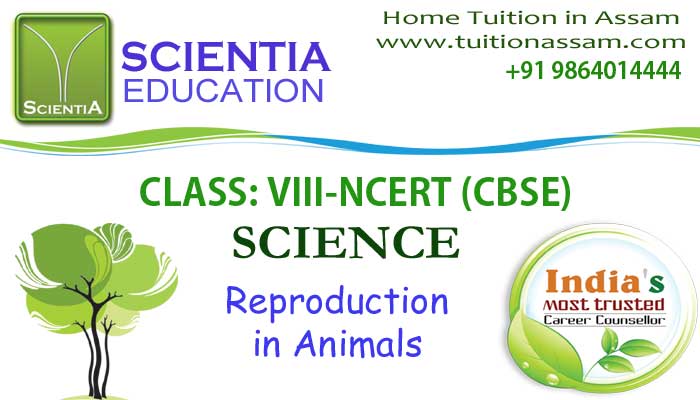
CLASS: VIII NCERT (CBSE)
Biology
Reproduction in Animals
SUMMARY
Sexual Reproduction in Animals
Amoeba and bacteria adopt the asexual mode of reproduction.Reproductive organs in humans producegametes – eggs and sperms.A zygote is formed by the fusion of an egg and a sperm.The male reproductive organs include a pair of testes, two sperm ducts, and apenis.Sperms have a head, a middle piece and atail.
Sperms contain cell membrane, cytoplasm andnucleus.The female reproductive organs consist of a pair of ovaries, two oviducts, also called fallopian tubes, and the uterus.The ovary produces female gametescalled ova or eggs.During pollination in plants, the male gamete fuses with the female gamete.
The nuclei of the sperm and the egg fuse to form a zygote, and the process is called fertilisation.An organism inheritssome characteristics from the egg and some from the sperm.Copulation is the act in which a male reproductive organ enters the female reproductive tract.
When male and female gametes unite outside the body, it is called external fertilisation.When fertilisation takes place inside the body, it is called internal fertilisation.When fertilisation takes place in a test tube, the offspring are called test tube babies.Fertilisation that takes place outside the human body is in vitro fertilisation.Super cell – the zygote, marks the beginning of a new individual.
The zygote divides repeatedly to form a ball of cells, which, in turn, develops into tissues andorgans of the body.The development of the embryotakes place in the mother’s uterine wall.All parts of the body start developing in an embryo, called foetus.
Oviparous and Viviparous Animals
Oviparous animals undergo external fertilisation, whileviviparous animals undergo internal fertilisation.Thezygote undergoes rapid division after fertilisation and moves down the oviduct. During this period, many protective layers form as a hard shell around the developing embryo.
The chick hatches from the egg after three weeks.There are three distinct stages in the life cycle of a frog – egg, tadpole and adult.In the first stage, the egg fuses with a sperm to form a zygote. The zygote further divides to form an early tadpole, which matures into a late tadpole.During metamorphosis, the larvatransforms into an adult frog.Our bodies undergo certain changes as we develop from childhood toadolescence stage.
Asexual Reproduction in Animals
In asexual reproduction, only one parent is involved.Binary fission involves the splitting of an organism into two.Amoeba is a simple, unicellular organism.Reproduction in amoeba begins with thedivision of the nucleus.The parent organism divides into two individual organisms is fragmentation or binary fission.Bulges that appear as outgrowths on hydra are called buds. These buds separate as new individuals, called budding.Dolly was the first cloned mammal, and is genetically identical to its parent sheep.
Cloning is creating an exact copy of a biological entity.Aclone is created by inserting the complete genetic material of a regular body cell from a donor into arecipient.Sheep are viviparous animals, and sopropagate their offspring sexually.Sir Ian Wilmut fromRoslin Institute in Edinburgh, Scotland created Dolly.
A mammary gland cell of the Finn Dorsett sheep species and an enucleated cell of the Scottish Blackface ewe were subjected to an electric pulse to cause fusion, thereby resulting in a fertilised egg that developed into a zygote.The embryo was implanted into the uterus of the ewe to undergo rapid cell division to form a foetus.Offspring inherit characteristics from both the parents.Dolly received all the genetic information from the Finn Dorsett sheep.
Dolly produced several offspring.Cloning involves certainabnormalities.Dolly suffered from arthritis.Cloning could impact mental development.Advocates of human therapeutic cloning believe that cloning could help in producing organs for transplantation and inregenerative medicine.













